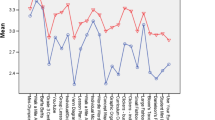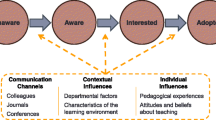Abstract
Normative expectations for acceptable behaviors related to undergraduate instruction are known to exist within academic settings. Yet few studies have examined disciplinary variation in norms for interactive teaching, and their relationship to teaching practice, particularly from a cognitive perspective. This study examines these problems using survey (n = 436) and interview (n = 56) data collected from faculty at three research universities in the United States in math, physics, chemistry, biology and geology departments. These data are analyzed using quantitative (i.e., ANOVA and ANCOVA) and qualitative (i.e., thematic and causal network analysis) techniques to provide multi-faceted accounts of normative systems. Results indicate that perceived norms for interactive teaching are weak or non-existent, yet other types of norms including those regarding course content, tacit norms for instructional autonomy and norms instantiated in course syllabi are present. Significant differences in perceived norms were found between institutions and disciplines, with biology and physics departments at two research sites exhibiting significantly stronger norms than other departments. Analyses of relationships between perceived norms and teaching practice indicated significant relationships between norm strength and the use of two teaching methods. Further, analyses of interview data revealed complex chains of decision-making involving considerations of course syllabi, student characteristics, and feedback mechanisms. Implications for pedagogical reform include the need to understand local cultural conditions and decision-making patterns to inform program design and implementation.



Similar content being viewed by others
Notes
By faculty, we mean all people who hold undergraduate teaching positions (excluding graduate student teaching assistants)—whether full- or part-time, tenured or untenured—in postsecondary institutions.
References
Aarts, H., & Dijksterhuis, A. (2003). The silence of the library: Environment, situational norm, and social behavior. Journal of Personality and Social Psychology, 84(1), 18–28.
Ajzen, I., & Fishbein, M. (1980). Understanding attitudes and predicting social behavior. Englewood Cliffs, NJ: Prentice Hall.
Austin, A. E. (1990). Faculty cultures, faculty values. New Directions for Institutional Research, Winter (68), 61–74.
Austin, A. E. (1994). Understanding and assessing faculty cultures and climates. New Directions for Institutional Research, Winter (84), 47–63.
Bandura, A. (1977). Self-efficacy: Toward a unifying theory of behavioral change. Psychological Review, 84(2), 191–215.
Bargh, J. A., & Williams, E. L. (2006). The automaticity of social life. Current Directions in Psychological Science, 15(1), 1–7.
Bayer, A. E., & Braxton, J. M. (1998). The normative structure of community college teaching: A marker of professionalism. Journal of Higher Education, 69(2), 187–205.
Braxton, J. M. (2010a). The criticality of norms to the functional imperatives of the social action system of college and university work. The Journal of Higher Education, 81(3), 416–429.
Braxton, J. M. (2010b). Norms and the work of colleges and universities: Introduction to the special issue—Norms in academia. The Journal of Higher Education, 81(3), 243–250.
Braxton, J. M., & Bayer, A. E. (1999). Faculty misconduct in collegiate teaching. Baltimore: Johns Hopkins University Press.
Braxton, J. M., Bayer, A. E., & Finkelstein, M. (1992). Teaching performance norms in academia. Research in Higher Education, 33(5), 533–569.
Braxton, J. M., Eimers, M. T., & Bayer, A. E. (1996). The implications of teaching norms for the improvement of undergraduate education. Journal of Higher Education, 67, 603–625.
Chi, M. T. H. (1997). Quantifying qualitative analyses of verbal data: A practical guide. The Journal of the Learning Sciences, 6(3), 271–315.
Clark, B. (1983). The higher education system: Academic organization in cross-national perspective. Berkeley: University of California Press.
Corbin, J., & Strauss, A. (2007). Basics of qualitative research: Techniques and procedures for developing grounded theory. Thousand Oaks, CA: Sage.
Dancy, M., & Henderson, C. (2010). Pedagogical practices and instructional change of physics faculty. American Journal of Physics, Physics, 78(10), 1056–1063.
Durkheim, E. (1897/1951). Suicide. New York: Free Press.
Feldon, D. F., Timmerman, B. C., Stowe, K. A., & Showman, R. (2010). Translating expertise into effective instruction: The impacts of cognitive task analysis (CTA) on lab report quality and student retention in the biological sciences. Journal of Research in Science Teaching, 47(10), 1165–1185.
Geertz, C. (1973). The interpretation of cultures. New York: Basic Books.
Gigerenzer, G., & Goldstein, D. G. (1996). Reasoning the fast and frugal way: Models of bounded rationality. Psychological Review, 103, 650–669.
Glaser, B. G., & Strauss, A. L. (1967). The discovery of grounded theory: Strategies for qualitative research. New Brunswick, NJ: Aldine Transaction.
Goodenough, W. H. (1957). Cultural anthropology and linguistics. In P. Garvin (Ed.), Report of the 7th annual round table meeting on linguistics and language study. Washington, DC: Georgetown University Monograph Series.
Greeno, J. G. (1994). Gibson’s affordances. Psychological Review, 101(2), 236–342.
Greeno, J. G. (1998). The situativity of knowing, learning, and research. American Psychologist, 53(1), 5–26.
Halverson, R. (2003). Systems of practice: How leaders use artifacts to create professional community in schools. Educational Policy Analysis Archives, 11(37), 1–34.
Henderson, C., & Dancy, M. H. (2008). Physics faculty and educational researchers: Divergent expectations as barriers to the diffusion of innovations. American Journal of Physics, 76, 79.
Herskovits, M. (1964). Man and his works: The science of cultural anthropology. New York: Alfred A. Knopf.
Hora, M. T. (2012). Organizational factors and instructional decision-making: A cognitive perspective. The Review of Higher Education, 35(2), 207–235.
Knight, P. T., & Trowler, P. R. (2000). Department-level cultures and the improvement of learning and teaching. Studies in Higher Education, 25(1), 69–83.
Kroeber, A. (1944). Configurations of culture growth. Berkeley: University of California Press.
Lattuca, L. R. (2005). Faculty work as learning: Insights from theories of cogntion. New Directions for Teaching and Learning, 102, 13–21.
Lazerson, M., Wagner, U., & Shumanis, N. (2000). What makes a revolution? Teaching and learning in higher education, 1980–2000. Change, 32(3), 13–19.
Martin, J. (2002). Organizational culture: Mapping the terrain. Thousand Oaks, CA: Sage Publications, Inc.
Merton, R. K. (1976). The sociology of social problems. In R. K. Merton & R. Nisbet (Eds.), Contemporary social problems (pp. 3–43). New York: Harcourt Brace Jovanovich.
Miles, M. B., & Huberman, A. M. (1994). Qualitative data analysis (2nd ed.). Thousand Oaks, CA: Sage Publications.
National Research Council. (2000). How people learn: Brain, mind, experience and school: Expanded edition. Washington, DC: National Academy Press.
National Research Council. (2010). Rising above the gathering storm, revisisted: Rapidly approaching category 5. Washington, DC: National Academy Press.
Neumann, R., Parry, S., & Becher, T. (2002). Teaching and learning in their disciplinary contexts: A conceptual analysis. Studies in Higher Education, 27(4), 405–417.
Parsons, T. (1951). The social system. New York: The Free Press.
Rimal, R. N., & Real, K. (2003). Understanding the influence of perceived injunctive norms on behaviors. Communication Theory, 13(2), 184–203.
Seymour, E. (2002). Tracking the processes of change in US undergraduate education in science, mathematics, engineering, and technology. Science Education, 85(6), 79–105.
Shavelson, R. J., & Stern, P. (1981). Research on teachers’ pedagogical thoughts, judgments, decisions, and behavior. Review of Educational Research, 51, 455–498.
Simon, H. A. (1991). Bounded rationality and organizational learning. Organization Science, 2, 125–134.
Spradley, J. P. (1977). The ethnographic interview. New York, NY: Harcourt, Brace & Janovich.
Sripada, C. S., & Stich, S. (2007). A framework for the psychology of norms. In P. Carruthers, S. Laurence, & S. Stich (Eds.), Innateness and the Structure of the Mind (Vol. II, pp. 280–301). Oxford: Oxford University Press.
Stark, J. S. (2000). Planning introductory college courses: Content, context and form. Instructional Science, 28(5), 413–438.
Strauss, C., & Quinn, N. (1998). A cognitive theory of cultural meaning. Cambridge: Cambridge University Press.
Tashakkori, A., & Teddlie, C. B. (Eds.). (2002). Handbook of mixed methods social and behavioral research. Thousand Oaks: Sage Publications.
Tierney, W. G. (2008). The impact of culture on organizational decision-making: Theory and practice in higher education. Sterling, VA: Stylus Publishing.
Trowler, P. R., & Cooper, A. (2002). Teaching and learning regimes: implicit theories and recurrent practices in the enhancement of teaching and learning through educational development programmes. Higher Education Research and Development, 21(3), 221–240.
Umbach, P. D. (2007). Faculty cultures and college teaching. In R. P. Perry & J. C. Smart (Eds.), The scholarship of teaching and learning in higher education: An evidence-based perspective. New York: Springer.
Whitt, E. J. (1993). Making the familiar strange: Discovering culture. In G. D. Kuh (Ed.), Cultural perspectives in student affairs work. Washington, DC: American College Personnel Association.
Author information
Authors and Affiliations
Corresponding author
Rights and permissions
About this article
Cite this article
Hora, M.T., Anderson, C. Perceived norms for interactive teaching and their relationship to instructional decision-making: a mixed methods study. High Educ 64, 573–592 (2012). https://doi.org/10.1007/s10734-012-9513-8
Published:
Issue Date:
DOI: https://doi.org/10.1007/s10734-012-9513-8




